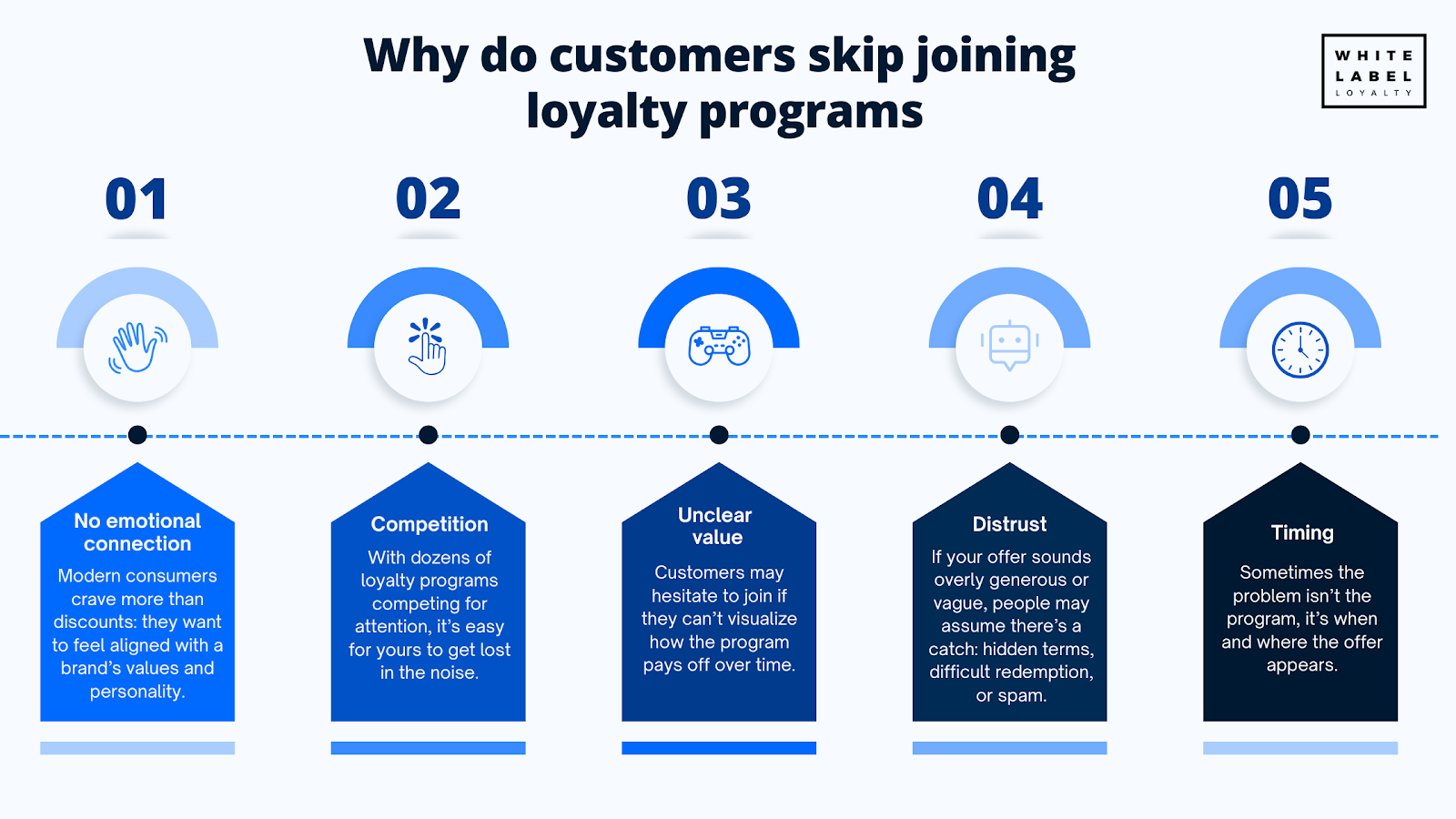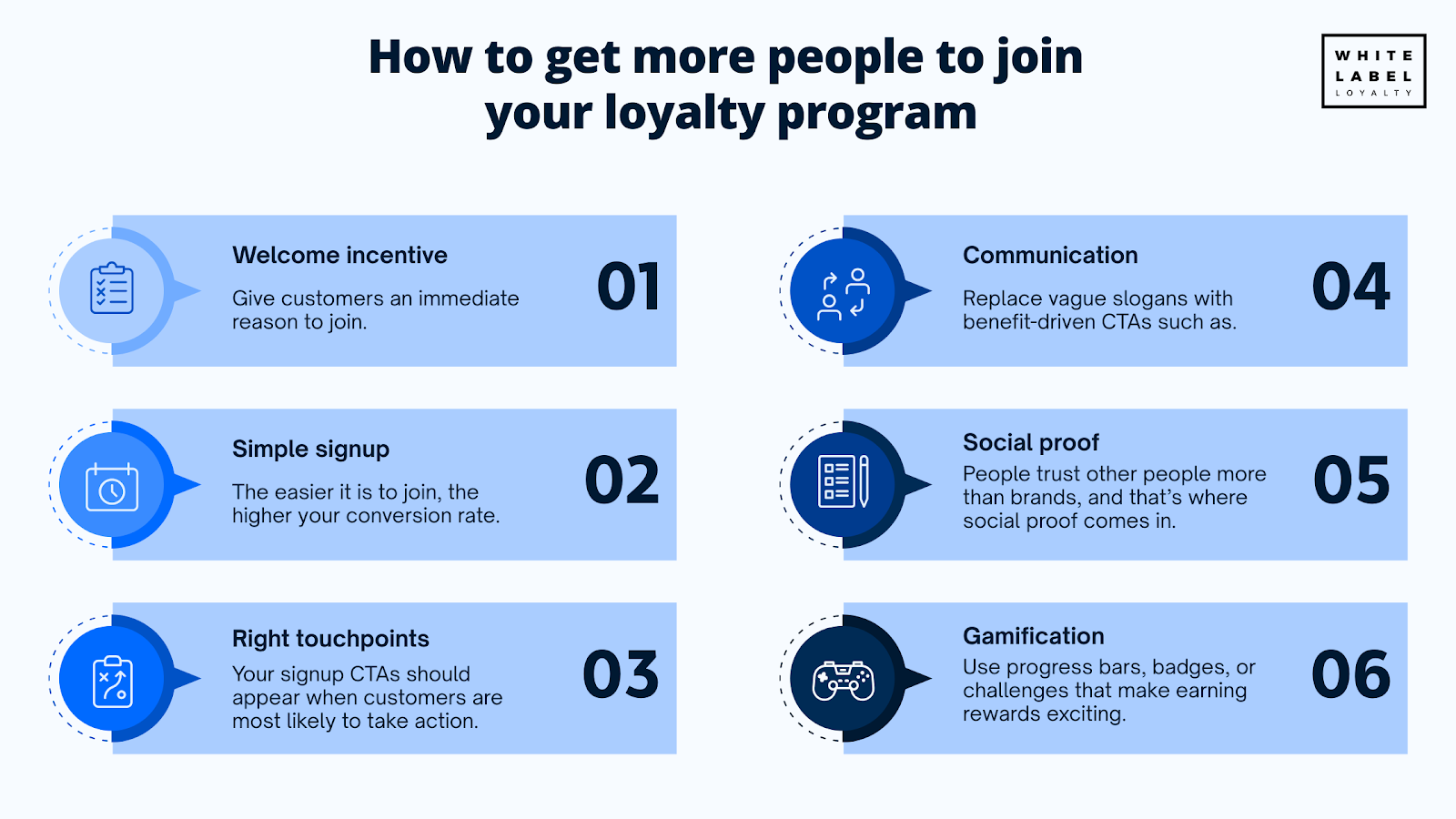How to Increase Loyalty Program Signups: Proven Strategies
Loyalty programs are one of the most powerful tools for turning casual customers into repeat buyers. But even the best-designed program is useless if people don’t sign up.
Increasing loyalty program signups right now is all about delivering clear value, removing friction, and meeting customers where they are. From mobile apps and email campaigns to in-store promotions and gamified experiences, there are proven strategies that drive customer engagement and enrollment.
In this guide, you’ll discover data-backed tactics to boost your loyalty program signups, improve member activation, and ultimately turn more visitors into loyal, revenue-generating customers.
Whether you’re a retailer, restaurant, B2B brand, or something else, these strategies will help you maximize your customer loyalty programs’ potential and your brand loyalty.
Why loyalty program sign-ups matter
The most successful brands use loyalty programs to transform existing customers and casual shoppers into long-term advocates. Yet even the best program fails if loyalty members don’t sign up.
So how can you increase loyalty program signups and turn more visitors into members?
The answer lies in understanding what motivates customers to join, removing friction from the process, and communicating value clearly at every touchpoint. When done right, loyalty programs drive repeat sales, boost customer retention, and strengthen brand trust.
For example, consumers ages 18 to 34 are more drawn to free content and media, exclusive benefits, and digital engagement through social and mobile channels, while those who are 35 and older are more interested in benefits that offer monetary benefits.
Why do customers skip joining loyalty programs?
Even when loyalty rewards programs look appealing on paper, many customers still decide not to join. The hesitation often has less to do with the program itself and more with how it’s perceived, positioned, and communicated.
Understanding these underlying motivations can help you design experiences that convert curiosity into commitment and ultimately into loyalty program members and loyal customers.
1. Lack of emotional connection to brand values
Modern consumers crave more than discounts: they want to feel aligned with a brand’s values and personality. If your program feels purely transactional, customers may not see a reason to join.
Example: Brands that tie their loyalty programs to sustainability, community, or purpose (like donating points to charity or rewarding eco-friendly choices) often see stronger participation because they appeal to emotion, not just savings.
2. Customer behavior & overwhelming choice
Customers are bombarded with offers from multiple brands daily. With dozens of loyalty programs competing for attention, it’s easy for yours to get lost in the noise.
Fix the perception: Focus on differentiation. What makes your program unique? Exclusive experiences, premium tiers, or non-monetary rewards? Clear positioning helps your program stand out in a crowded landscape.
3. Unclear long-term value of loyalty program participation
Customers may hesitate to join if they can’t visualize how the program pays off over time. A one-time reward feels fleeting, while a well-explained progression (earn more as you spend more) builds anticipation.
Opportunity: Showcase how rewards accumulate and what members typically achieve in the first few months. A “what you’ll earn by staying active” preview can make the journey feel worthwhile.
4. Distrust or “too good to be true” perception
If your offer sounds overly generous or vague (“Earn unlimited rewards!”), people may assume there’s a catch: hidden terms, difficult redemption, or spam.
Solution: Transparency builds trust. Make your terms clear, highlight real member experiences, and display reviews or testimonials that validate the program’s credibility.
5. Timing and context issues
Sometimes the problem isn’t the program, it’s when and where the offer appears. Asking a first-time visitor to join before they’ve even explored your products can feel premature.
Fix: Present the invitation at meaningful touchpoints: after checkout, during a thank-you email, or when a visitor shows repeated interest. Timing your invite around genuine engagement moments can drastically improve acceptance rates.

What is a good loyalty program signup rate?
If you’re wondering “What’s a good loyalty program signup rate?”, the short answer is: it depends on your industry and channels.
Across sectors, average signup rates typically look like this:
Industry | Average Signup Rate | Notes |
| Retail | 30–50% | Higher when promoted at checkout or via email |
| Hospitality (hotels, restaurants) | 50–70% | Increases with mobile app integration |
| E-commerce | 20–35% | Higher when promoted with targeted campaigns |
| Healthcare | 25–45% | Higher when rewarding for regular check-ups |
Generally, a signup rate above 30% is considered strong, especially if members continue engaging after joining.
But signup numbers alone don’t tell the whole story. A “good” rate is one that drives active participation: customers who not only join but earn, redeem, and return.
Track both signup conversion rate (visitors → members) and activation rate (members → active users). High signups without engagement usually signal a weak value proposition.
Examples of brands with high-performing customer loyalty programs
Seeing real-world success can inspire your strategy. Here are a few examples of successful loyalty programs that truly encourage customer participation:
- Starbucks Rewards program: Offers tiered points, mobile app gamification, and instant rewards, leading to millions of active members.
- Dubai Holding - Tickit: The UAE’s second-largest loyalty program, Tickit rewards members instantly across 3,000+ outlets in 10 sectors. The program’s frictionless experience has driven rapid growth, surpassing 1,000 signups in its first month.
- Sephora Beauty Insider: Tiered levels, birthday gifts, and personalized offers drive high engagement.
- Burger King Rewards: Mobile-first program with fast signup at checkout and app notifications, boosting enrollment and retention.

The best ways to get more loyal members to join your loyalty program
So, how do you actually increase loyalty program signups?
The key is to remove friction, amplify perceived value, and make joining feel instantly rewarding. Below are proven, high-impact strategies.
1. Offer an irresistible welcome incentive
Give customers an immediate reason to join. That could mean a one-time discount (e.g., 10% off first purchase), bonus points for signing up, free shipping, or early exclusive access.
Brands that offer a first-purchase incentive and encourage sign ups see signup increases of 30–50%, according to Growave research.
Why it works: People love instant gratification. When they see immediate value and immediate loyalty program benefits like early access, signup rates rise sharply.
2. Simplify the signup process
The easier it is to join, the higher your conversion rate. Keep your forms short, ideally just a name and email, and allow one-click registration via Google, Apple, or social logins. Every extra step is a potential dropout point.
Embed signup opportunities naturally across the customer journey: at checkout, inside your mobile app, in confirmation emails, or even through QR codes in-store. Frictionless onboarding builds momentum.
More than 67% of site visitors will abandon your form forever if they encounter any complications, and only 20% will follow up with your brands in some way.
3. Promote the program at high-intent touchpoints
Your signup CTAs (and overall loyalty program marketing) should appear when customers are most likely to take action.
Key spots where you can engage customers are checkout pages, popups on thank-you or order confirmation pages, mobile app home screens, and email footers and receipts.
Why it matters: Customers already in a buying mindset are more likely to join when presented with a clear, relevant offer and enrollment process.

4. Communicate value clearly to encourage customers
Replace vague slogans like “Join our rewards program” with benefit-driven CTAs such as:
- “Earn rewards every time you shop”
- “Get 10% back in points instantly”
Be transparent about how rewards work and when they can be redeemed: a clear value message builds trust, and trust drives conversions.
5. Use social proof to attract loyalty members
People trust other people more than brands, and that’s where social proof comes in. Showing that others find your loyalty program valuable can instantly boost credibility and motivate hesitant visitors to join.
Here are a few ways to integrate social proof effectively:
- Feature real customer stories – Share testimonials, reviews, or short videos of members talking about their favorite perks. Authentic experiences resonate far more than marketing copy.
- Show live activity or dynamic stats – Highlight recent redemptions or milestones, such as “5,000 rewards redeemed this week!” or “2,000 new members joined this month.”
- Use social media – Repost user-generated content, celebrate loyalty milestones, or spotlight “member of the month” features to humanize your brand.
Gravitate: turning engagement into loyalty
With Gravitate, brands can take social proof a step further by rewarding followers directly for actions like mentions, shares, and DMs on Instagram. The platform transforms social engagement into measurable loyalty, helping businesses collect first-party data, boost signups, and turn social credibility into real customer growth.

6. Use gamification, social proof, and tiered rewards
Gamification turns loyalty into motivation. Use progress bars, badges, or challenges that make earning rewards exciting. Tiered systems (“Silver, Gold, Platinum”) give members something to strive for, while visible achievements create social validation.
This sense of belonging and achievement triggers FOMO and strengthens emotional loyalty. Gamified loyalty programs can increase engagement by up to 47% and loyalty participation by 30%.
How to track and optimize your loyalty program signups
Having a customer engaged is amazing, but you also need to make sure you measure and refine the data you have to maximize impact.
Run A/B tests on signup forms, incentives, and placement, track which channels bring the most engaged members, and iterate your messaging based on what generates the highest activation.
When tracking data, focus on these key metrics:
- Signup Conversion Rate – % of visitors who join the program.
- Activation Rate – % of new members who take their first action (redeem points, make a purchase).
- Engagement Rate – Frequency of member interactions with emails, app, or in-store rewards.
- Cost per Acquisition (CPA) – How much it costs to acquire each new member.
- Retention & Repeat Purchase Rate – Are your members sticking around and driving revenue?
Frequently Asked Questions (FAQs
1. How do seasonal promotions affect loyalty program signups?
Limited-time offers, holiday bonuses, or seasonal challenges can spike signups by creating urgency and highlighting the program’s value in a specific context.
2. Can mobile apps increase loyalty program enrollment?
Yes. Mobile apps streamline signups, provide instant rewards, and allow push notifications that drive engagement, making enrollment easier and more attractive.
3. How can personalization improve loyalty program conversions?
Tailoring rewards, messages, and content to customer behavior increases perceived value, which encourages more users to join and remain active in the program.
4. What role does email marketing play in growing loyalty membership?
Targeted email campaigns, such as post-purchase prompts or abandoned cart reminders, can significantly increase signups by presenting the program at high-intent moments.
5. How can partnerships and co-branded campaigns boost loyalty signups?
Collaborating with complementary brands expands your reach, exposes new audiences to your referral programs, and provides joint incentives that encourage enrollment.
6. Are QR codes effective for in-store loyalty program registration?
Yes. QR codes simplify signups at checkout or on product displays, reducing friction and making it convenient for customers to join instantly.
7. How does social media influence loyalty program adoption?
Sharing rewards, achievements, or exclusive offers on social channels builds awareness and trust, encouraging followers to enroll in your program.
8. How can testing and optimization improve program enrollment?
A/B testing forms, incentives, CTA placement, and messaging help identify what drives the most signups and allow continuous improvement of the signup funnel.
Conclusion
When you simplify the journey, show clear value, and build trust through data-driven personalization and social proof, signups become the start of long-term customer relationships.
If you’re ready to grow your loyalty membership and turn engagement into lasting connections, talk to our team at White Label Loyalty. From seamless signups to omnichannel engagement, we’ll help you build a loyalty experience that converts and keeps customers coming back.
Recommended Posts
If you enjoyed this article, check out these relevant posts below.
Share this Article
Sara Rabolini
Content Marketing Executive
Sara is our Content Marketing Executive. She shares engaging and informative content, helping businesses stay up-to-date with the latest trends and best practices in loyalty...